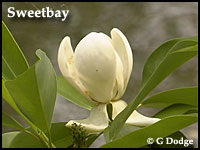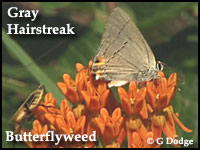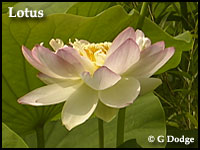 June brought the blooming of two Magnolias around the Catch the Wind and Explore the Wild Loop, Sweetbay and Southern Magnolia (or simply Magnolia). Most people are familiar with the large white, fragrant flowers of Southern Magnolia. Sweetbay is often overlooked as its flowers and leaves are not as large as Southern Magnolia, but they are just as fragrant. You can see Sweetbay planted around the Wetlands. Many grow along the boardwalk and are about 10-12 feet in height.
June brought the blooming of two Magnolias around the Catch the Wind and Explore the Wild Loop, Sweetbay and Southern Magnolia (or simply Magnolia). Most people are familiar with the large white, fragrant flowers of Southern Magnolia. Sweetbay is often overlooked as its flowers and leaves are not as large as Southern Magnolia, but they are just as fragrant. You can see Sweetbay planted around the Wetlands. Many grow along the boardwalk and are about 10-12 feet in height.
 Butterflyweed, Pickerelweed, and Lizard’s-tail have come into flower. Don’t let the names of the first two fool you, these flowers stand out for both their beauty and their ability to attract nectaring insects. All three flowers can be found in or near the U-shaped pond next to the Ornithopter in Catch the Wind.
Butterflyweed, Pickerelweed, and Lizard’s-tail have come into flower. Don’t let the names of the first two fool you, these flowers stand out for both their beauty and their ability to attract nectaring insects. All three flowers can be found in or near the U-shaped pond next to the Ornithopter in Catch the Wind.
Butterflyweed is a milkweed (Asclepia) and attracts Monarch butterflies to lay their eggs on the plant’s leaves. Another plant out on the loop that resembles a milkweed but is not related, is Dogbane. If you break a stem of the Dogbane plant a white, toxic, viscous substance will ooze out, much like milkweed. When the plant goes to seed, the seeds are presented in a pod that splits open to reveal fluff-tipped seeds, also like milkweed. Dogbane won’t attract Monarchs as a host plant for laying eggs, but it will attract many different butterflies and other insects to its flowers as a source for nectar. Much as the milkweeds have certain creatures that are drawn to it, Dogbane has its own unique set of characters that utilize the plant. As the season progresses we’ll most likely run into some of those creatures. Other names that have been used for this plant are Indian Hemp, American Hemp, Indian Physic, and Rheumatism Weed.
Buttonbush (just starting), Trumpet Creeper, Queen Anne’s Lace, and Swamp Rose (not the invasive white-flowered Multiflora Rose but the pink native varieties) are blooming as well. Buttonbush is hard to resist for butterflies and other nectar-loving insects. Trumpet Creeper is favored by hummers. A variety of insects are attracted to Queen Anne’s Lace; Black Swallowtails may lay eggs on the plant. Look for beetles on the Rose, especially Longhorn and Soldier Beetles.
 Currently, the star of the show is the Lotus down in the Wetlands. With its huge green pads and large, fragrant, pastel-colored flowers, Lotus is hard to beat. The pads provide cover and shade for many breeding frogs and other creatures living in the Wetlands. Lotus is spectacular.
Currently, the star of the show is the Lotus down in the Wetlands. With its huge green pads and large, fragrant, pastel-colored flowers, Lotus is hard to beat. The pads provide cover and shade for many breeding frogs and other creatures living in the Wetlands. Lotus is spectacular.